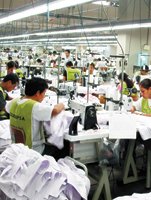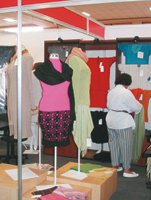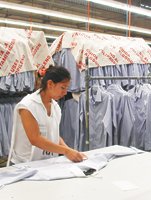Peru Picks Up Pace to Stay Vital in Apparel World
LIMA, Peru—As a slew of struggling Latin American countries wage a heated battle to save their apparel and textile industries in a quota-free world, Peru is counting on Pima.
Many Peruvian apparel producers are building a niche business using this high-grade cotton, grown in the coastal desert of the Andean country.
This is what attracted Eddie Habash, a Los Angeles wholesaler of men’s T-shirts, to Peru Moda 2005, the apparel sourcing show held April 27–29 in Lima. This was the ninth year for the show, which saw exhibitors nearly double to 250 over last year and foreign buyer attendance more than triple to 500.
Habash was one of those new buyers in search of a better product. “I think the T-shirt market is still growing in the United States but on the higher end,” said the wholesaler, whose company is called Navigator Clothing Inc. “So I’m looking for companies to produce T-shirts with higher-end cotton.”
Higher-end cotton is Peru’s distinguishing factor and may be the saving grace for the country’s growing apparel and textile industry since apparel and textile quotas expired on Jan. 1 for World Trade Organization members.
Peru is known for its Pima cotton, a long-staple product that turns ordinary shirts into luxurious confections with the feel of silk. Its fibers make shirts, skirts and nightgowns more durable and softer.
Pima cotton has given Creditex, Peru’s largest apparel factory for woven goods, the upper edge in competing with China. It helped the business, which has nine plants and 3,000 workers, grow 15 percent last year to reach $87 million in revenues.
“We are putting all our efforts on the high end,” said Kenneth Wilson, Creditexacute;s commercial manager for the apparel division.
That high-end niche is concentrated on quality men’s and women’s shirts, which right now make up about 75 percent to 80 percent of the company’s production. Creditex makes about 170,000 garments a month for such labels as Marshall Field’s, Polo by Ralph Lauren, Nautica and Lacoste. But the company is branching out, conducting more research and development to create its own designs and products that would keep its nine plants busy. The company handles everything from gin cotton to the finished product. Creditex is also moving into alpaca and woolen scarves and shawls and is expanding its textile business for the home furnishings industries.
It is companies such as Creditex, founded in 1990 by a corporation that made beer until competition got too stiff, that have helped Peru’s apparel and textile industry grow. Last year, Peru exported $690 million in goods, mostly knit shirts, to the United States. That is up from $405.6 million in 2000, according to International Development Systems, a Washington, D.C.–based company that keeps track of apparel quotas and import numbers.
Most of Peru’s apparel exports to the United States have been helped by the Andean Trade Promotion Drug Eradication Act, passed in 2002. The act allows certain garments to enter the United States market duty- and quota-free. But Peru and other South American countries are counting on the Free Trade Area of the Americas, which would create a free trade zone from Alaska to Argentina, to further grow the apparel industry—if the trade measure is ever negotiated.
Limatex was formed only two years ago to capitalize on these new free-trade accords. This young company, with 650 employees, does brisk T-shirt and polo shirt business with several U.S. companies. One of its biggest customers is Abercrombie & Fitch, which buys anywhere from 150,000 to 200,000 tops a month from the Peruvian company.
Timing is money
Patricio Luzanto, the general manager at Limatex, knows full well that his company can’t compete with China, which everyone likens to a 900-pound monster. He holds up a T-shirt to make his point.
“In Peru, if it costs $1.35 to make this shirt, it will cost $1 to make it in China,” he explained. “Peru can only survive in two ways. One is adding value to differentiate its product from China with Pima cotton, and the other is to improve its delivery on time.”
On-time delivery is a secret weapon for many apparel companies, and it is one of the manufacturing ingredients that Peru still has to work on. After all, this is a country where everything seems to start at least 30 minutes late and business appointments get delayed.
Tony Ronayne, vice president of Western Hemisphere operations for Liz Claiborne Inc., emphasized that on-time delivery was a key factor for his company. Speaking at a seminar at Peru Moda 2005, he noted that Liz Claiborne works with 250 vendors in 35 countries. But the company plans to reduce its sourcing countries to 10 to 15 and its number of vendors. Currently, Peru makes up only 2 percent of the company’s worldwide production. Whether that grows is up to Peruvian apparel executives. China has a 20 percent share.
“Some 40 percent of our sourcing decisions were affected by quotas,” Ronayne said. Now the determining factors are superior-quality goods, human rights compliance, speed-to-market and having C-TPAT [Customs-Trade Partnership Against Terrorism] partners. “Those with a vibrant business will survive,” he explained.
That is what Textiles San Sebastian is shooting for. The 50-year-old Lima-based company is run by the Tang family and employs 700 workers. Textile San Sebastian has been looking beyond Peru for the past 15 years to grow its company. Now 95 percent of its production of cotton T-shirts, cotton underwear and other goods is exported to the United States and Europe.
One of its goals is to expand its blank T-shirt market, said Ines Tang Chea, one of the company’s owners.
“I know that companies like American Apparel and Bella in California are doing this,” said Chea, who recently attended the Action Sports Retailer Trade Expo in San Diego. “These are people we want to compete with.”
For now, Pima cotton is Peru’s secret ingredient. “For us, happiness is that China doesnacute;t produce this cotton yet,” said Luzanto of Limatex.
























